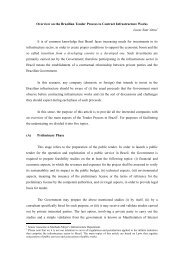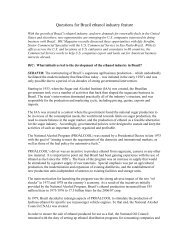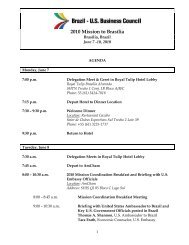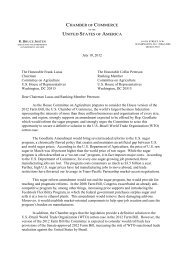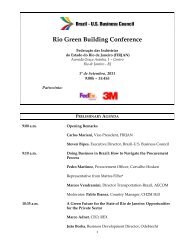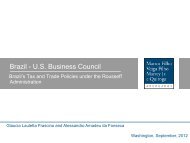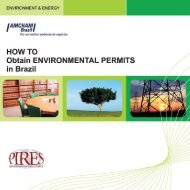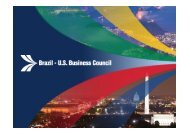Presentation - Brazil-US Business Council
Presentation - Brazil-US Business Council
Presentation - Brazil-US Business Council
Create successful ePaper yourself
Turn your PDF publications into a flip-book with our unique Google optimized e-Paper software.
<strong>US</strong>- <strong>Brazil</strong> Bilateral Cooperation Perspectives<br />
1
Telecommunication<br />
Incumbents<br />
Land lines lines access<br />
<strong>Business</strong> Groups<br />
The main groups are organized as follows:<br />
Cell phones, Pay TV and<br />
broadband<br />
Public service with obligation to<br />
provide services for all<br />
customers<br />
Competitive market
Telecommunication<br />
<strong>Business</strong> Groups<br />
Net Revenue 2010 of Six Major Groups in <strong>Brazil</strong><br />
(R$ billion)<br />
Source: Teleco
Telecommunication<br />
<strong>Business</strong> Groups<br />
Market Leaders by Market Segment<br />
(percentage of penetration in each market)<br />
América Móvil<br />
Source: Teleco
Telecommunication<br />
<strong>Business</strong> Groups<br />
Market Leaders by Total All-Service Access<br />
(million subscribers)<br />
Source: Teleco
Telecommunication<br />
Telecom Infrastructure<br />
<strong>Brazil</strong> is the 6th largest mobile market in the world.<br />
The growth of subscribers 1997-2011<br />
Source: Teleco
Telecommunication<br />
Telecom Infrastructure<br />
Though with high density of cell phones (107 lines/ 100 habitants)<br />
the subscriber base is still growing at a constant rate.<br />
Cell Phones Net Additions per Quarter<br />
Source: Teleco
Telecommunication<br />
Telecom Infrastructure<br />
Though the base is growing, one of the biggest challenges<br />
from the mobile market is low revenue per user (ARPU) but<br />
has been overcome with the increase in service data revenues.<br />
Data Service Revenue from Total Revenue<br />
Source: Teleco
Telecommunication<br />
<strong>Business</strong> Opportunities for New Competitors:<br />
Mobile Virtual Network Operator<br />
Based on these numbers, Anatel (<strong>Brazil</strong> telecom regulator) published<br />
in November 2010, a new regulation allowing the entry of new<br />
competitors in mobile market: “Mobile Virtual Network Operator”.<br />
Allows the operation of companies, not holding the mobile telephone network,<br />
the provision of services to specific markets and customers through sharing of<br />
infrastructure with the carriers.<br />
The Porto Seguro (insurance company ) in association with the operator TIM<br />
(Telecom Italia) is the first to request the license in <strong>Brazil</strong>.
Telecommunication<br />
<strong>Business</strong> Opportunities for New Competitors:<br />
There are approximately 85 million worldwide phone subscribers<br />
through a mobile virtual operator (MVNO).<br />
The largest companies by number of subscribers operating in the U.S. market:<br />
• Tracfone with 15 million subscribers (the America Móvil group);<br />
• Virgin Mobile with 5 million worldwide subscribers (acquired by Sprint in 2009)<br />
According to the consultancy E-Consulting Corp., the MVNOs will reach 6.5% of<br />
penetration in <strong>Brazil</strong>ian market.<br />
Mobile Virtual Network Operator
Telecommunication<br />
Broadband Infrastrucuture<br />
The infrastructure of fixed broadband reached 94% of the population<br />
(backbone + backhaul) but as seen in the graph, the number of<br />
access is still low due to the high cost of service, a problem that is<br />
expected to be resolved with the Federal Government Broadband National<br />
Plan (PNBL).<br />
Source: Anatel e Teleco
Telecommunication<br />
Digital Television Broadcasting<br />
The highlights of system adopted in <strong>Brazil</strong> for the digitalization of TV:<br />
• free service, including broadcasts for cell phones;<br />
• the National Technology Middleware (GINGA) that will provide interactivity<br />
for the user in future for shopping and online games.<br />
After three years of operation, The <strong>Brazil</strong>ian Digital Television System (SBTVD-T),<br />
based on Japanese standard (ISDB-T), is already present in 425 cities, covering<br />
89.5 million people.<br />
Source: Teleco
Telecommunication<br />
Digital Television Broadcasting<br />
For the purpose of promoting regional integration, all Latin American<br />
countries, except Colombia, have adopted the Japan-<strong>Brazil</strong> Digital TV<br />
standard.<br />
Adopted the ISDB-T standard (Japan-<strong>Brazil</strong> standard)<br />
Adopted the DVB-T standard (European standard)<br />
Adopted the ATSC (American standard)<br />
No standard yet<br />
Source: Teleco
Transport<br />
Transport Modal Mix<br />
Present and Future<br />
2005 2025<br />
13%<br />
3,6% 0,4%<br />
29%<br />
5%<br />
1%<br />
25%<br />
35%<br />
58%<br />
100%<br />
100%<br />
30%<br />
Road Rail Waterway Pipeline Air<br />
Source: PNLT
Transport<br />
National Logistics and Transportation Plan -<br />
1. Geo-referenced database<br />
PNLT<br />
In 2006, the <strong>Brazil</strong>ian Federal Government launched the National<br />
Logistics and Transportation Plan (PNLT) based on:<br />
2. Economic optimazation of the transport fuel<br />
3. Integration of the regional plan<br />
4. Logistical aspects taken into account (cost & time)<br />
5. Inventory / Warehousing / Distribution / Multimodality<br />
6. Participation of all interested civil sectors.<br />
Investiments of R$ 290 billion (2006-2025).
Transport<br />
Highways<br />
Highways:<br />
1.7 million km<br />
Highway<br />
concessions:<br />
15 thousand km<br />
(administrated by 52<br />
companies)
Transport<br />
Highways - Investiments<br />
Federal Highways:<br />
PNLT Planned<br />
Investiments:<br />
R$ 70 billion<br />
Period R$ (billion)<br />
2008-2011 47.0<br />
2012-2015 10.5<br />
After 2015 12.5<br />
Total 70.0<br />
Main Highway Development in the<br />
State of São Paulo: “Ring Road”<br />
(Northern stretch – 42.8 km - R$ 4.85<br />
billion).
Transport<br />
Railroads<br />
Railroads – 29,817 km<br />
12 concessions: operated by 5 private groups and 1 state company (VALEC).<br />
PNLT Planned Investments:<br />
R$ 150 billion<br />
2,700 km construction<br />
1,500 km planned<br />
5,300 km modelling<br />
2,500 km in analisis<br />
Period R$ (billion)<br />
2008-2011 34<br />
2012-2015 53<br />
After 2015 63<br />
Total 150
Transport<br />
Railroad Expansion<br />
Prolongamento Norte da Ferrovia Norte–Sul<br />
Barcarena/PA – Açailândia/TO - 450 km<br />
Barcarena<br />
Conexão Transnordestina/Norte–Sul<br />
Eliseu Martins/PI–Estreito/MA – 400 km<br />
Pecém<br />
Ferrovia Norte–Sul – Trecho Norte<br />
Aguiarnópolis/TO – Palmas/TO – 720 km<br />
Ferrovia de Integração Centro–Oeste<br />
Uruaçu/GO–Vilhena/RO – 1.600 km<br />
Vilhena<br />
Ferrovia Norte–Sul – Trecho Sul<br />
Palmas/TO –Estrela do Oeste/SP – 1.535 km<br />
Sorriso<br />
Açailândia<br />
Aguiarnópolis<br />
Palmas<br />
Figueirópolis<br />
Uruaçu<br />
Eliseu Martins<br />
Luís Eduardo<br />
Ibotirama<br />
Brumado<br />
Missão Velha<br />
Salgueiro<br />
Ilhéus<br />
Ferrovia Nova Transnordestina<br />
Missão Velha/CE – Salgueiro/PE – 1.728 km<br />
Recife<br />
Suape<br />
Salvador<br />
Reconstrução Ferroviária<br />
Recife/PE–Propriá/AL – 550 km<br />
Ferronorte Alto Araguaia – Rondonópolis – 260 km<br />
Anápolis<br />
Ferrovia da Integração Oeste–Leste<br />
Ilhéus/BA–Figueirópolis/TO – 1.444 km<br />
Prolongamento Sul da Ferrovia Norte–Sul<br />
Estrela d’Oeste — Panorama–Porto Murtinho – 900 km<br />
Ferroeste - Cascavel/PR–Maracajú/MS – 600 km<br />
Antofagasta – Chile<br />
Corredor Ferroviário Bioceânico<br />
Santos/SP – Antofagasta/Chile – 2.930 km<br />
Porto Murtinho<br />
Maracajú<br />
Estrela D’oeste<br />
Cascavel<br />
Chapecó<br />
Resistência – Argentina<br />
Panorama<br />
Imbituba<br />
Ferrovia Frango/SC<br />
Itajaí/SC–Chapecó/SC – 549 km<br />
São Paulo<br />
Santos<br />
Paranaguá<br />
Araquari<br />
Itajaí<br />
Belo Horizonte<br />
Itaguaí<br />
Ferrovia Litorânea/SC<br />
Imbituba/SC–Araquari/SC – 235 km<br />
Variante Ferroviária Oeste do Paraná - 130 km<br />
RailRoad Gauge<br />
Wide (1,6 m)<br />
Construction<br />
Project<br />
Narrow (1,0 m)<br />
Construction<br />
Project
Transport<br />
Highspeed Train - “TAV Brasil”<br />
Linking the city of –<br />
Campinas - São Paulo -<br />
Rio de Janeiro<br />
Lenght: 511 Km<br />
Planned Investiment: R$<br />
33.1 billion<br />
Estimated conclusion:<br />
2016<br />
Auction: 04/29/11
Transport<br />
Urban Mobility Projects: Metro and Trams<br />
Collective Transport System and Metro<br />
expansion to 11 municipalities.<br />
• Current Metro length: 215.7 km<br />
• Planned Expansion: 133 km by 2022<br />
• Planned Investment: R$ 105 billion
Transport<br />
Inland Waterways<br />
Lenght: 28.000 km<br />
• Currently in operation:<br />
13,000 km<br />
• New Operation<br />
potential >15,000 km,<br />
totaling 43,000 km.<br />
• Main ports: 15
Transport<br />
Inland Waterways<br />
PNLT Planned Investiments: R$<br />
16.0 bilion<br />
Structuring the current main<br />
waterway corridors: (dredging,<br />
demolishing, sinalization and cargo<br />
terminals)<br />
Period R$ (billion)<br />
2008-2011 4.0<br />
2012-2015 7.0<br />
After 2015 5.0<br />
Total 16.0<br />
Total Waterway Terminals for<br />
passangers (Current & Planned): 34
Transport<br />
Ports<br />
• 34 main marine ports<br />
• Plans in port infrastructure<br />
• Dredging<br />
• Passanger terminals<br />
• Logistic Intelligence<br />
• Planned Investment by 2014:<br />
• Public R$ 5.1 billion<br />
• Private: R$ 6.0 billion<br />
Period<br />
R$ (billion)<br />
2008-2011 18.0<br />
2012-2015 8.0<br />
After 2015 13.0<br />
Total 39.0<br />
The Federal Government is<br />
developing a National Port Logistic<br />
Plan, to be released in December<br />
2011
Transport<br />
Airports<br />
• 67 main airports; 34 international<br />
• Annual Passenger Movement:<br />
• 2003: 71 million<br />
• 2010: 155 million<br />
• 2014: 190 million<br />
• 10.3% Annual Passenger Growth<br />
Source: Infraero
Transport<br />
Airports<br />
• Infraero Planned Investiments<br />
• by 2014: R$ 5.6 billion (World Cup).<br />
• between 2014 -2016: R$ 3.1 billion (Rio<br />
Olympic Games)<br />
Period R$ (billion)<br />
2008-2011 5.0<br />
2012-2015 4.0<br />
After 2015 3.7<br />
Total 12.7<br />
• Planned PNLT Investiments: R$ 12,7<br />
bilhões<br />
• Federal Government announced the<br />
restructurization of the sector, with the<br />
creation of the Secretary of Airports.<br />
Source: Infraero
World Cup<br />
Expectation from the Fifa World Cup:<br />
Unite the Country<br />
Promote the Country<br />
in the World<br />
Build World Class<br />
Multi-use Stadiums<br />
Service upgrades<br />
Infrastructure<br />
Modernization
World Cup<br />
World Cup - 2014<br />
12 sites:<br />
• Belo Horizonte,<br />
• Brasília,<br />
• Cuiabá,<br />
• Curitiba,<br />
• Fortaleza,<br />
• Manaus,<br />
• Natal,<br />
• Porto Alegre,<br />
• Recife,<br />
• Rio de Janeiro,<br />
• Salvador,<br />
• São Paulo.
World Cup<br />
World Cup - 2014<br />
Direct Investments:R$ 47 billion<br />
Infrastructure •Construction: R$ 23 billion<br />
•Service: R$ 10 billion<br />
Tourism<br />
•600 thousand Int’ tourists(R$ 3.9 billion)<br />
•3 million domestic tourists (R$ 5.5 billion)<br />
Jobs<br />
Generation<br />
•Permanent: 332 thousand (2009-2014)<br />
•Temporary: 381 thousand (2014)<br />
Consumption • Growth: R$ 5.0 billion (2009-2014)<br />
Revenues<br />
•Total: R$ 16.8 billion
World Cup<br />
EstimationAdded: ~ R$ 183 billion to the <strong>Brazil</strong>ian GDP until 2019 (or +0.4%<br />
per year)<br />
135,7 183,2<br />
R$ Billion<br />
47,5<br />
Indirect<br />
TotaI Impact<br />
Direct<br />
•Infrastructure Investments<br />
•Cash flow<br />
•Tourism Spending<br />
•Increase in domestic<br />
consumption<br />
•Increase of Tourism and<br />
the use of Stadiums<br />
after the World Cup<br />
+0,4%<br />
in GDP<br />
2010-2019
World Cup<br />
Planned Investments up to now: R$ 24.8 billion<br />
•Stadiums= R$<br />
5,075 million<br />
•Local= R$ 783<br />
million<br />
(São Paulo<br />
stadium not<br />
included)<br />
5.9<br />
3,0<br />
2,9<br />
11.6<br />
7,7 11,5<br />
3,9<br />
1,0<br />
0,7<br />
5,6 24,8<br />
5,2<br />
0,4<br />
5,9<br />
7,3<br />
Local resources<br />
Federal Finance<br />
Ofederal Budgetl<br />
Estádios e<br />
entorno<br />
Mobilidade<br />
Urbana<br />
Hotelaria Portos Aeroportos Total<br />
# Projetos 11 51 n.d<br />
7 13<br />
83<br />
+ Projects in:<br />
• Security<br />
• Telecom/IT<br />
• Energy<br />
• Health<br />
• Tourism Infrastructure<br />
• Professional Qualification
World Cup<br />
Stadiums<br />
Site Invest. Current Situation Site Invest. Current Situation<br />
Manaus<br />
533<br />
Plus local<br />
Construction<br />
started<br />
533<br />
Fortaleza<br />
projects financed by BNDES<br />
452<br />
Construction<br />
started<br />
Cuiabá<br />
597<br />
Plus local<br />
Construction<br />
started<br />
Natal<br />
*<br />
413<br />
Bidding<br />
Brasília<br />
*<br />
São<br />
Paulo<br />
702<br />
-<br />
Construction<br />
started<br />
TBD<br />
Recife<br />
Salvador<br />
678<br />
Plus Local<br />
630<br />
com entorno<br />
Waiting for the<br />
Bidding<br />
Construction<br />
started<br />
Curitiba<br />
*<br />
Porto<br />
Alegre<br />
*<br />
185<br />
Plus local<br />
154<br />
Plus local<br />
Construction<br />
started<br />
Construction<br />
started<br />
Belo<br />
Horizonte<br />
*<br />
Rio de<br />
Janeiro<br />
684<br />
Plus<br />
Local<br />
828<br />
Plus<br />
Local<br />
Construction<br />
started<br />
Construction<br />
started
Energy Overview<br />
Energy Mix<br />
Primary Energy Demand by Fuel Type<br />
12,271<br />
(MTOE)<br />
16,725<br />
(MTOE)<br />
World<br />
Non-<br />
Renewable<br />
87%<br />
Renewable<br />
13%<br />
Hydro 2%<br />
Biofuels 0,4%<br />
Other<br />
Renewables 1%<br />
Biomass<br />
10%<br />
Non-Renewable<br />
84%<br />
Renewables<br />
16%<br />
Hydro 3%<br />
Biofuels 1%<br />
Other<br />
Renewables 3%<br />
Biomass<br />
10%<br />
2008 2030<br />
245<br />
(MTOE)<br />
572<br />
(MTOE)<br />
<strong>Brazil</strong><br />
Non-<br />
Renewable<br />
55%<br />
Renewable<br />
45%<br />
Hydro 2%<br />
Biofuels 5%<br />
Non-<br />
Renewable<br />
54%<br />
Renewable<br />
46%<br />
Hydro 13%<br />
Biofuels 10%<br />
Other<br />
Renewables 2%<br />
Biomass<br />
27%<br />
Biomass<br />
21%<br />
Source: IBP
Energy Overview<br />
Energy Mix<br />
World<br />
<strong>Brazil</strong><br />
2.2%<br />
10.5%<br />
1.5%<br />
6%<br />
13.8%<br />
26.5%<br />
5.9%<br />
20.9%<br />
36.7%<br />
31.5%<br />
34.0%<br />
10.3%<br />
Hydro Biomass Natural Gas Oil and derivatives Nuclear Coal<br />
Source: Key World Energy Statistics 2009 - IEA
Energy Overview<br />
Power Generation<br />
World<br />
2.6%<br />
15.6%<br />
<strong>Brazil</strong><br />
4.8% Wind;<br />
2.8% 1.6% 0.1%<br />
3.0%<br />
6.0%<br />
41.5%<br />
20.9%<br />
81.7%<br />
13.8%<br />
5.6%<br />
Hydro<br />
Oil and derivatives<br />
Coal<br />
Natural Gas<br />
Nuclear<br />
Other<br />
Hydro<br />
Natural Gas<br />
Oil and derivatives Nuclear<br />
Coal<br />
Biomass<br />
Wind<br />
Source: Key World Energy Statistics 2009 - IEA
Power Generation<br />
Energy Generation Institutional Framework<br />
• Planning: Ten Year Energy Plan – “PDE 2019” and National Energy<br />
Plan – “PNE 2030”.<br />
• Guarantee of Supply: transmission and generation auctions,<br />
lowest tariff with long term contracts (15 or 30 years PPA).<br />
• Optimized Tariff: lowest tariff auctions and distribution and<br />
transmission reviews.<br />
• Universal Access: “Light for Everyone” Program and “Social Tariff.
Power Generation<br />
Institutional Management<br />
• Policy and Planning:<br />
National <strong>Council</strong> of Energy Policy – CNPE<br />
Ministry of Minning and Energy – MME<br />
Energy Research Center – EPE<br />
• Regulation:<br />
National Electrical Power Agency – ANEEL<br />
• Operator:<br />
National System Operator – ONS<br />
• Commercialization:<br />
Electrical Power Commercialization Chamber - CCEE
Power Generation<br />
Expansion Summary<br />
2009 2019<br />
Ten-year<br />
Incremental<br />
%<br />
Installed Capacity (GW) 103.6 167.0 63.4 61%<br />
Hydro 81.5 116.7 35.2 43%<br />
Nuclear 2.0 3.4 1.4 70%<br />
Thermal 13.3 25.4 12.1 91%<br />
Alternative Sources 6.8 21.5 14.7 116%<br />
Transmission<br />
Transmission Lines (Km) 95,582 132,379 36,797 38%<br />
Sub-stations (MVA) 206,212 282,351 76,139 37%<br />
Fonte: EPE (PDE 2019)
Power Generation<br />
Investiment Estimates<br />
R$ Billion<br />
(2010-2019)<br />
Total Electrical 214 22.5%<br />
Generation 175 18.4%<br />
Transmission 39 4.1%<br />
Total Oil and Natural Gas 672 70.6%<br />
Exploration and Production 506 53.1%<br />
Oil Derivative Supply 151 15.9%<br />
Natural Gas Supply 15 1.6%<br />
Total Liquid Biofuels 66 6.9%<br />
Ethanol – Production Plants 58 6.1%<br />
Ethanol – Pipelines 7 0.8%<br />
Biodiesel – Production Plants 0.5 0.1%<br />
Total 952 100%<br />
%<br />
Source: EPE (PDE 2019)
Power Generation<br />
Hydropower Expansion<br />
9000<br />
Installed Capacity Growth (MW)<br />
8000<br />
7000<br />
6000<br />
5000<br />
4000<br />
3000<br />
2000<br />
1000<br />
0<br />
1716<br />
2314<br />
812<br />
2205<br />
110<br />
1071<br />
3086<br />
1890<br />
2401<br />
3419<br />
5656<br />
2003<br />
1231<br />
2444 2444 2444<br />
Planned<br />
Contracted<br />
2010 2011 2012 2013 2014 2015 2016 2017 2018 2019<br />
Source: EPE (PDE 2019)
Power Generation<br />
Alternative Energy Expansion<br />
Installed Capacity Growth of 14.6 GW (2010-2019) from the following<br />
sources:<br />
Contracted & Planned Expansion<br />
Wind<br />
36%<br />
Small<br />
Hydro<br />
27%<br />
Biomass<br />
37%<br />
Small<br />
Hydro<br />
Wind<br />
6.8GW expansion contracted (2010-<br />
2012)<br />
7.85GW planned (2013-2019)<br />
116% Growth<br />
Biomass<br />
3.9 GW 5.3 GW 5.4 GW<br />
Source: EPE (PDE 2019)
Power Generation<br />
Alternative Energy Expansion<br />
Installed Capacity Growth (MW)<br />
3985<br />
776<br />
Contracted<br />
2044<br />
1150<br />
1350<br />
1250<br />
Planned<br />
850 800<br />
1100<br />
1350<br />
2010 2011 2012 2013 2014 2015 2016 2017 2018 2019<br />
Source: EPE (PDE 2019)
Power Generation<br />
Nuclear Expansion<br />
• Angra III comissioning in 2015, adding 1.4GW to the total<br />
installed capacity.<br />
• Studies in progress for nuclear development in the South, South-<br />
East and North-East Regions.<br />
Installed Capicity Growth (MW)<br />
1500<br />
1250<br />
1000<br />
750<br />
500<br />
250<br />
0<br />
2010 2011 2012 2013 2014 2015 2016 2017 2018 2019<br />
Angra III<br />
Source: EPE (PDE 2019)
Oil<br />
Total Oil and Gas Production<br />
Total Petrobras production will increase 1,255 thousand boepd by 2013, an<br />
annual average increase of 8.8%.<br />
Oil Production - <strong>Brazil</strong><br />
Gas Production - <strong>Brazil</strong><br />
Oil & Gas Production - World<br />
Source: Petrobras
Oil<br />
Oil Expansion<br />
• Major investments in oil prospecting and exploration .<br />
• National Production Growth from 2.0 to 5.1 Mb/day<br />
Estimated Oil<br />
Production Growth by<br />
2019 is 155%<br />
2019<br />
Source: EPE (PDE 2019)
Oil<br />
Number of Concessions<br />
Concessions<br />
(Jan – 2010)<br />
Petrobras<br />
Other Companies<br />
(2009)<br />
Total<br />
<strong>Brazil</strong><br />
Exploration 143 182 325<br />
Plans 38 0 38<br />
Production 286 38 324<br />
Total 467 220 687
Oil<br />
Number of Concessions
Oil<br />
Industries : Other Statistic Data<br />
Refining Capacity: 2.0 mbpd<br />
Expansion to meet demand: 2.3 mbpd by 2013<br />
Expansion to meet export: + 0.9 mmbpd by 2015 (Premium refinement)<br />
Natural Gas:<br />
Reserves: 423 million cubic meters( excluding Pre-salt)<br />
Domestic Production: 53 million cubic meters per day (high growth rate)<br />
Consumo doméstico: 60 million cubic meters per day (135 in 2013)<br />
Pipelines: 22,500 KM (GAS: 9,840 km )<br />
<strong>US</strong>$ 8 billion investment to construct 7,400 km by 2013<br />
Pipeline distribution: 18,000 km<br />
Natural Gas Vehicle (NGV)<br />
3rd largest Light Vehicles Fleet in the world: 1.6 million vehicles<br />
1,700 Service stations<br />
Fonte: IBP , Gas Energy
Oil<br />
Investiment<br />
2010-2014<br />
Exploration & Production (E&P)<br />
Oil & Natural Gas (O&G)<br />
Other<br />
20%<br />
Other<br />
17%<br />
Petrobras<br />
80%<br />
Petrobras<br />
83%<br />
Total <strong>US</strong>$ 135 billion<br />
Petrobras Other<br />
<strong>US</strong>$ 108 billion <strong>US</strong>$ 27 billion<br />
Total <strong>US</strong>$ 250 billion<br />
Petrobras Other<br />
<strong>US</strong>$ 208 billion <strong>US</strong>$ 42 billion<br />
Source: IBP e Petrobras
Oil<br />
Challenges World Oil Supply<br />
• Worldwide Production in 2008: 86 mbpd;<br />
• Worldwide Production in 2030: 31 mbpd (excluding new discoveries);<br />
• Global demand in 2030: 106 mbpd;<br />
• Deficit– 75 mbpd supplied by:<br />
• New discoveries;<br />
• Alternative energy;<br />
• Increase in energy efficiency.<br />
In all world economic growth scenarios,<br />
new major oil discoveries will be<br />
necessary to meet expected demand
Oil<br />
Pre-Salt Region
Oil<br />
São paulo – oil & gas exploration/ production<br />
UGN<br />
RPBC<br />
UTGCA<br />
PMXL-1<br />
170 Km<br />
URG<br />
PMLZ-1<br />
TEFRAN<br />
SS-11<br />
Área do<br />
TUPI<br />
Fonte: Petrobras
Oil<br />
Petrobras HQ Project in SANTOS/SP<br />
Fonte: Petrobras
Oil<br />
Offshore Production Evolution<br />
124m<br />
189m<br />
293m<br />
383m<br />
492m<br />
781m<br />
1027m<br />
Platform<br />
1709m<br />
1863m<br />
1877m<br />
1886m<br />
2200m<br />
2500m<br />
Source: IBP & Petrobras
Oil<br />
Petrobras – Exploration & Production Oil Technology<br />
6,000m below surface<br />
Source: Petrobras
Oil<br />
Pre-Salt<br />
The pre-salt layer is a strip located up to 300 km (180 miles)<br />
offshore, along 800 km (500 miles) of coastline in the southeast of<br />
<strong>Brazil</strong>. The oil lies at depths that exceed 7,000 meters underneath a<br />
thick layer of salt that conserves the quality of the oil. This is the<br />
first large reserve of light oil found in <strong>Brazil</strong>.<br />
Source: UBS Pactual e Folha de São Paulo
Oil<br />
Pre-Salt – Santos Basin<br />
Total Area: 149,000 km²<br />
Granted Area: 41,772 km² (28%)<br />
Granted area with Petrobras: 35,739 km² (24%)<br />
Area without Concession: 107,228 km² (72%)<br />
Currently, proved reserves (post-salt): 19 billion barrels.<br />
Guaranteed 19 years of production<br />
FIESP estimates that Pre-Salt reserves could reach<br />
100 billion BOE<br />
source: Petrobras
Oil<br />
Pre-Salt<br />
World’s Largest Oil Producers<br />
Optimistic Realistic Present Forecast Day: ~ 14.9 billion 100 billion 150 boe (17 (2 (5 nd th )<br />
Source: Crédit Suisse (adapted)
Oil<br />
Exploration modeling<br />
How it<br />
works?<br />
Concession Regime<br />
- Concessionaries pay through<br />
exploration, assuming the risks &<br />
own the production<br />
Sharing Regime<br />
- The State is the owner of the oil<br />
and gas production<br />
Who<br />
explores?<br />
- Winner of the auction: who pays<br />
the highest bid<br />
- Winner of the auction: who<br />
grants the biggest share to the<br />
State<br />
Who<br />
operates?<br />
- Any participant of the winning<br />
consortium<br />
- Petrobras will the only operator
Ethanol<br />
Overview<br />
► 456 facilities producing ethanol from sugarcane and<br />
generating electricity from bagasse in 2008.<br />
► 100% of <strong>Brazil</strong>’s sugar and ethanol factories are selfsufficient<br />
in electricity.<br />
► 5.31% of <strong>Brazil</strong>’s energy mix, corresponding to an<br />
installed capacity of 6,254 MW, are from bioelectricity from<br />
sugarcane bagasse.<br />
► <strong>Brazil</strong> has world-class expertise in the technology and<br />
construction of ethanol plants that generate electricity by<br />
burning sugarcane bagasse.<br />
Source: UNICA, ANEEL
Ethanol<br />
Sugarcane Products<br />
• Sugar (food )<br />
• Ethanol (fuel and other uses)<br />
• Biodiesel (transesterification process)<br />
• Diesel ( lower GHG emissions up to 80%)<br />
(different from biodiesel – Amyris technology)<br />
• Biorefineries (Green Plastics: ethylene, bio-polyethylene, bio-PVC, bio-PET)<br />
• Cogeneration Power (burning sugarcane and straw in the plants)<br />
• Ethanol Turbine (Power generation - VSE)<br />
• Biogas (Power Generation)
Ethanol<br />
The success of <strong>Brazil</strong>’s ethanol program has been driven by two key factors:<br />
► R&D on genetic improvement of sugarcane<br />
► Technological innovation in the automotive industry<br />
<strong>Brazil</strong> is the world’s sixth-largest producer and fifth-largest market of automotive vehicles.<br />
It produced more than 3 million in 2007. The number of vehicles in circulation exceeds 26<br />
million. Today ethanol accounts for over 50% of the fuel use, including E25 gasoline<br />
mixture.<br />
Source: ANP
Ethanol<br />
Car & Light Commercial Vehicles:<br />
Consumption<br />
2% 3%<br />
World<br />
<strong>Brazil</strong><br />
1%<br />
4%<br />
39%<br />
56%<br />
48%<br />
47%<br />
Diesel Gasoline Ethanol Other<br />
Source: ANP 2009, FIESP 2009
Ethanol<br />
Flex-Fuel<br />
• The flex-fuel engine is a highly creative invention. It enables consumers to use<br />
gasoline, ethanol or any blend of the two.<br />
• Ethanol costs approximately 40% less than gasoline at the fuel pump in <strong>Brazil</strong>.<br />
This generates competitiveness for the entire economy because it helps keep<br />
down the price of gasoline. Also, greenhouse gas emissions are significantly<br />
reduced, making ethanol a “green fuel”.<br />
• The <strong>Brazil</strong>ian automotive industry developed the first ethanol-powered car in<br />
1976. But the real breakthrough came with the development of flex-fuel<br />
technology in 2003.<br />
Source: Anfavea
Ethanol<br />
Flex-Fuel<br />
Here are the automotive manufacturers that produce flex-fuel vehicles in <strong>Brazil</strong>:<br />
Ask Your Local Dealer When Flex-Fuel Technology<br />
Will Be Available In Your Country.
Ethanol<br />
Ethanol and Climate Change<br />
• February 2010: the U.S. Environmental Protection Agency<br />
confirmed that ethanol from sugarcane is a low carbon renewable<br />
fuel.<br />
• The American Agency has designated sugarcane ethanol as an<br />
advanced biofuel that lowers greenhouse gas emissions up to<br />
61%.<br />
By Adding 10% of sugarcane ethanol to gasoline;<br />
greenhouse gases emissions are reduced by 6.1%
Ethanol<br />
Sugarcane Productive Areas VS Amazon Rain Forest<br />
Source: Unica
Biodiesel<br />
Feedstock for Biodiesel<br />
Source:: Biodiesel Atlas - Biodiesel BR
Biodiesel<br />
Main Biodiesel Uses<br />
• Diesel Engine<br />
Can be added up to 10% with no engine modification.<br />
• Trains<br />
B5 with no engine modification and B20 & B100 with<br />
modified engines.<br />
• Planes<br />
biokerosene for aviation (TAM – A320 trial flight<br />
in 11/22/2010).
Carlos A. Cavalcanti<br />
Energy Head Director<br />
Infrastructure Department<br />
+55 11 3549-4401<br />
www.fiesp.org.br<br />
80



